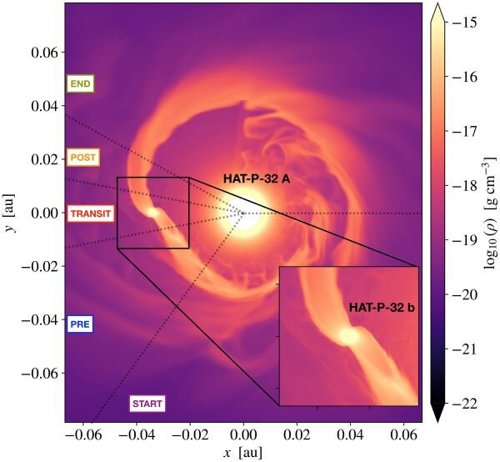In a remarkable breakthrough, a team of astronomers has made an astounding observation of colossal helium tails emanating from a Jupiter-like exoplanet. The exoplanet, known as WASP-107b, orbits a star located approximately 1,000 light-years away from Earth. This intriguing celestial body is so scorching hot that its atmosphere is gradually being eroded, leading to the escape of helium in the form of expansive tails that stretch across millions of miles into space.
Discovery using the Hubble Space Telescope: The monumental discovery was made possible by leveraging the capabilities of the Hubble Space Telescope. While studying the exoplanet's atmosphere, astronomers detected an extraordinary pattern of light emissions originating from its polar regions, resembling vast tails. Further analysis confirmed that these luminous emissions were indeed caused by the escape of helium gas from the planet's atmosphere.

Implications for our understanding of planets: This groundbreaking observation of enormous helium tails holds immense significance for advancing our knowledge of planetary formation and evolution. Scientists have long sought to unravel the mysteries surrounding the intricate processes involved in the birth and development of planets. While the formation of planets from residual dust and gas leftover after a star's formation is well known, the specific mechanisms governing the aggregation of these materials into planetary bodies remain elusive.
The existence of these colossal helium tails provides a unique opportunity to gain crucial insights into this formation process. They underscore the dynamic nature of planets, constantly shedding their atmospheres and undergoing transformative changes over time.
Moreover, this discovery sheds light on the intricate relationship between planets and their parent stars. The presence of these massive helium tails serves as compelling evidence of the significant influence exerted by the parent star on the planet itself.
Unraveling the mysteries: Although the discovery of these extraordinary helium tails raises many intriguing questions, scientists are determined to pursue further investigations. They are keen to uncover the duration of these tails and the ultimate fate of the escaping helium gas once it departs from the planet's atmosphere. Advanced telescopes and cutting-edge technologies will be employed to study the properties of these tails in greater detail.
The broader implications: The implications of this groundbreaking discovery extend beyond the realm of exoplanet research. The insights gained from studying the giant helium tails have the potential to enhance our understanding of planetary dynamics within our own solar system. By examining the interactions between planets and their host stars, scientists can refine existing models and theories, deepening our understanding of the intricate mechanisms that shape the cosmos.
Interesting information about the discovery of the giant helium tails:
- The planet WASP-107b is a hot Jupiter, a type of exoplanet that is very close to its parent star. The planet is so close to its star that it is tidally locked, meaning that the same side of the planet always faces the star.
- The intense heat from the star is evaporating the planet's atmosphere. The helium gas is the most easily evaporated gas, so it is the first to escape.
- The helium gas is escaping from the planet at a very high speed. The astronomers estimate that the gas is traveling at speeds of up to 100,000 miles per hour. The gas is so hot that it glows, which is why the astronomers were able to see it.
- The giant helium tails are thought to be temporary. The astronomers estimate that the tails will last for a few million years. After that, the helium gas will either escape into space or be recaptured by the planet's atmosphere.
- The discovery of the giant helium tails is a major breakthrough. It is the first time that astronomers have seen such a phenomenon. The discovery could help scientists better understand how planets form and evolve.
Here are some of the questions that scientists are still trying to answer about the giant helium tails:
- How long will the tails last?
- What will happen to the helium gas once it escapes the planet's atmosphere?
- How common are giant helium tails?
- What can giant helium tails tell us about the formation and evolution of planets?
Scientists are still learning about the giant helium tails. However, the discovery is a major breakthrough, and it could help scientists better understand how planets form and evolve.
Conclusion: The awe-inspiring observation of massive helium tails escaping from a Jupiter-like exoplanet marks a significant milestone in astronomical research. This remarkable discovery not only sheds light on the mechanisms behind planetary formation and evolution but also offers invaluable insights into the complex dynamics between planets and their parent stars. As scientists continue to unravel the mysteries surrounding these helium tails, they hold the promise of expanding our knowledge of celestial bodies and transforming our understanding of the universe.
Discover More
Most Viewed
Christmas is a season of joy, love, and traditions. And what better way to get into the holiday spirit than through timeless carols? These musical gems have been bringing people together for generations. Here’s our ranked list of the Top 10 Christmas Caro…
Read More
















